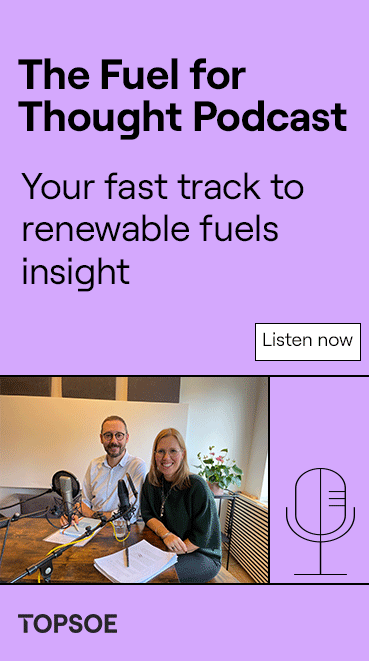Is There a Future for Biodiesel in Europe?
- Edgar Ahn
- Feb 1, 2024
- 8 min read
Updated: Feb 2, 2024

A comprehensive look at the policy landscape and market opportunities for fatty acid methyl esters in the European Union.
The two oil crises in 1973 and 1979—triggered by wars in the Middle East—shocked the Western world. For the first time, Europe in particular realized how dependent it was on energy imports. Drastic events such as queues at petrol stations, empty motorways and mandatory car-free days for car owners worried people greatly at the time.
At the same time, however, this period could also be considered the birth of biofuels. Many research groups began to focus on the topic of “alternative fuels” for internal-combustion engines that could be produced from regional raw-material sources.
A pioneer in the development of a diesel substitute fuel was Prof. Martin Mittelbach from the Karl-Franzens University in Graz, Austria. In the early 1980s, he produced fatty acid methyl ester (FAME) from vegetable oils in his laboratory, a chemical substance that was very similar to diesel fuel in terms of its combustion properties. Thus began the age of biodiesel. Austria played a pioneering role worldwide in the development of the production and use of biodiesel. The world’s first pilot plant for the production of rapeseed oil-based biodiesel was built in a viticulture school in Styria, Austria. The biodiesel produced there underwent numerous engine tests at the Graz University of Technology to assess its suitability as an alternative diesel fuel. Based on this research, Austria introduced the world’s first state quality standard for biodiesel, and in 1994, buses in the city of Graz began using 100 percent biodiesel as a fuel.
It was also around this time that the plant-construction company BDI was founded, which developed an industrial process for biodiesel production in close cooperation with Mittelbach and the Graz University of Technology. Since then, BDI has successfully built and commissioned over 40 industrial plants for biodiesel production worldwide and established itself as a technological benchmark for multifeedstock biodiesel production.
Global biodiesel production increased enormously, especially between 2000 and 2020. In Europe, legal-framework conditions—especially the Renewable Energy Directives (RED I to III)—have led to an average of around 7 percent of diesel-fuel consumption in Europe currently being covered by biodiesel.
But has this development had the desired effect of reducing greenhouse-gas (GHG) emissions in the transport sector in Europe? Unfortunately, the answer is “no.” The transport sector in the EU27 countries, which is responsible for a third of all GHG emissions, is the only sector in which no reduction in emissions has been achieved since 1991. On the contrary, emissions are still rising sharply.
The EU Commission has recognized that more drastic measures must therefore be taken in the transport sector in order to achieve the goals of the 2015 climate conference in Paris—namely limiting the global temperature increase to 1.5 degrees Celsius. In December 2019, the EU Commission presented the Green Deal—its political declaration of intent to make the EU the first climate-neutral continent by 2050. The European Climate Law of June 2021 transformed this declaration of intent into a legal obligation for the member states. In July 2021, the EU Commission presented the Fit for 55 action package, which sets out the measures required to drive the necessary change in the EU’s economy, society and industry. Many of the regulations in Fit for 55 directly affect the transport sector.
In particular, the promotion of the electrification of road transport is expected to bring about the hoped-for reductions in emissions. In addition, restrictions on the authorization of combustion engines are intended to phase out this technology starting in 2035.
A group of experts from the Dutch Rabobank anticipates a sharp decline in new registrations of vehicles with internal-combustion engines from around the mid-2020s, with a simultaneous increase in electric vehicles (EVs) and a significant rise in plug-in hybrid vehicles. However, such a development would mean that the share of biofuels in road transport would fall drastically starting in the 2030s (see Figure 1).

The currently planned legal framework for biofuels within Fit for 55 also offers little potential, particularly for the expansion of biodiesel in road transport.
The revised version of the Renewable Energy Directive (RED III) contains the following requirements, which will be binding for all member states (see Table 1):

The directive sets a common target for the share of renewable energies in EU energy consumption of 42.5 percent by 2030 and encourages the member states to further increase this share to 45 percent by 2030 on a voluntary basis.
The share of first-generation biofuels based on biomass (e.g., biodiesel from rapeseed oil or ethanol from corn) is limited to a maximum of 7 percent.
Biofuels produced from used cooking oil (UCO) and animal waste fats (Annex IX, Part B), such as biodiesel, hydrotreated vegetable oil (HVO) or hydroprocessed esters and fatty acids (HEFA) are limited to a share of 1.7 percent in 2030. This limit can be increased by individual member states with the approval of the EU. For the biodiesel industry, the currently discussed expansion of the range of raw materials in this annex would include the following five raw-material sources:
Damaged crops that are not fit for use in the food or feed chain.
Municipal wastewater and derivatives other than sewage sludge.
Cyanobacteria.
Nonfood crops grown on severely degraded land.
Intermediate crops, such as catch crops and cover crops that are grown in areas where, due to a short vegetation period, the production of food and feed crops is limited to one harvest; and provided their use does not trigger demand for additional land; and provided the soil organic matter is maintained.
These feedstocks represent an oil potential of several tens of millions of tons per year, but their inclusion in the annex is currently the subject of heated debate within EU legislation.
Strong growth is planned for biofuels based on raw materials from RED Annex IX Part A (currently 16 raw-material categories such as algae, lignocellulosic biomass, tall oil, etc.). Their share in the transport sector is set to increase from just under 1 percent in 2025 to 5.5 percent in 2030. However, the technologies for this category are generally not yet available on an industrial scale, meaning that the planned increase appears extremely ambitious.
A new group of alternative fuels—renewable fuels of nonbiological origin (RFNBO)—includes hydrogen and all eFuels, and their share within this advanced biofuel group should be at least 1 percent by 2030. However, the necessary production infrastructure is currently completely lacking and will require enormous investment in the coming years.
In contrast, the blending quotas for traditional biofuels are—incomprehensibly—not being increased and a B7 protection class will even be established by 2030. The opportunity to defossilize existing fleets in the transport sector more quickly by increasing the blending quotas is therefore unfortunately not being used by EU legislators.
The new ReFuelEU aviation regulation will force the aviation industry to reduce its GHG emissions (see Table 2). As electrification or the switch to hydrogen is still a long way off, sustainable aviation fuels (SAF) are currently the only way to defossilize the aviation sector.

The share of SAF should gradually increase from 2 percent in 2025 to 20 percent in 2035 and up to 70 percent in 2050.
As a subtarget, the share of eFuels in particular is to be significantly increased.
The raw-material source for the production of SAF should primarily be waste and residual materials or types of raw materials that fulfill the sustainability criteria of RED II, with some exceptions.
Large production capacities are currently being built up for a special type of fat-based SAF—the so-called HEFA. In Europe, only waste fats such as UCO or animal waste fats are to be used as feedstock for HEFA—the same raw materials that are currently used to produce biodiesel for road transport.
Figure 2 shows the expected development of the production of various fat-based biofuels. Global biodiesel production in 2021 was 45 million tons. Two-thirds of the raw material used was vegetable oils. The demand for fat-based biofuels is estimated at 150 million tons in 2040, mainly due to the drastic increase in SAF starting in the mid-2020s.

However, the expected quantities of waste oils will only increase slightly, so it is clear that the manufacturers of the various fat-based biofuels will be fighting for the coveted raw material of waste fat. This gap can only be closed if new raw-material sources are found or new production technologies reach industrial maturity.
Additionally, the question emerges regarding the optimal utilization of the limited raw materials. A study by the European Waste-based & Advanced Biofuels Association compared the production routes of HVO, HEFA and FAME based on UCO and found that the production of UCO-based biodiesel causes significantly less CO2 than the production of HVO or HEFA, due to the simpler and less energy-intensive production process. In addition, the production costs of HEFA are about 30 percent more expensive compared to biodiesel production. In combination, this leads to 67 percent higher CO2-avoidance costs compared to UCO-based biodiesel and HEFA (see figures 3a, 3b and 4).



A planned 2 percent blending mandate for aviation in 2025 could mean that at least 1.5 million tons of waste grease would be diverted from existing biodiesel production, resulting in 1 million tons of additional GHG emissions. Is it therefore justifiable to politically favor air transport over road transport, as envisaged in the new ReFuelEU aviation? Would it not be better to massively promote new technologies for SAF production (e.g., eFuels)?
Last but not least, the EU Commission is planning to reduce GHG emissions from maritime shipping through its own regulation—FuelEU maritime—in a similar manner to aviation. Here, technology-neutral percentages for the reduction of GHG emissions are set, starting at 2 percent in 2025 and gradually increasing to 80 percent in 2050 (see Table 3).

Due to the simpler drive technology, biodiesel is also a possible drop-in biofuel that is immediately available in large quantities. When biomethanol is employed as shipping fuel, biodiesel can serve as the necessary pilot fuel.
In addition, biodiesel could also utilize its forgotten advantages as a biodegradable biofuel that will not pollute the water (e.g., in comparison to renewable diesel).
Conclusion
So does biodiesel have a future in the course of defossilization of Europe’s transport sector? In the author’s opinion, this question can be answered as follows:
For the road transport sector:
Increasing electrification and the ban on internal-combustion engines will reduce the demand for biofuels in the passenger-car sector.
Significant additional GHG savings could be achieved in existing fleets if the blending quota for biodiesel, for example, is increased at the same time; however, this is currently not politically supported.
There may be a similar development of electrification for heavy commercial vehicles—but this depends very much on increasing the production of sustainable electricity, its distribution and the expansion of the charging infrastructure—with massive investments. If these investments are not made, or are made only slowly, biodiesel will remain a proven means of defossilizing this transport sector.
In areas of application that are difficult to electrify—for example construction-site vehicles—biofuels could remain the only option for defossilization for a long time to come.
By expanding the permissible range of raw materials to include “nonfood crops” and “intermediate crops,” the amount of oil required to expand biodiesel production in the future could be multiplied without jeopardizing food production or misusing valuable agricultural land.
For the aviation sector:
Fat-based SAF can be a drop-in solution, but at the expense of GHG savings in the road-transport sector.
Alternative biomass-to-liquid technologies are under development or have already reached technology-readiness level (TRL) 9 in some cases, especially ethanol from cellulose. However, large quantities of sustainable biomass are required as fuel yields are low.
Is aviation an opportunity for eFuels? We still need to find answers to open questions such as, “How quickly will these technologies reach industrial scale?” “Where will the sustainable electricity come from?” “Where will the biomass and water come from?” And, “Who will bear the high development costs?”
For the maritime-shipping sector:
Electrification of maritime shipping is possible in niches.
Biodiesel is already available in large quantities as a suitable drop-in fuel.
Biodiesel is also well-suited as a pilot fuel for maritime biomethanol applications.
Biodiesel also offers advantages in the maritime sector in terms of avoiding water pollution.

Author: Edgar Ahn
Chief Innovation Officer
BDI-BioEnergy International GmbH































